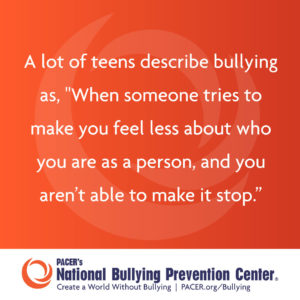In This Section
Bullying Defined
What Is Bullying?
Bullying is more than disagreements, differences of opinion, or conflicts that occur between friends, peers, and classmates. Kids who are bullied and those who bully others may develop serious, lasting problems.
Bullying definitions typically include:
- The target is being hurt or harmed by unwanted words or behavior
- The hurtful behavior is repeated or there is a concern that it will be repeated
- The target being hurt has a hard time stopping or preventing the unwanted behavior
- The hurtful behavior is carried out by those who have more (real or perceived) power, which is used to control or harm others. Power can mean students who are older, are physically stronger, have access to embarrassing information, have more social status, or are part of a group that is singling out an individual.
Note: This is not a legal definition, but rather a way to help understand and identify bullying. For your school’s definition, check the district’s bullying prevention policies. For a legal definition, consult your state’s law on bullying at StopBullying.gov
5 Unique Aspects of Cyberbullying | PACERTalks About Bullying: Season 3, Episode 22
How is Bullying Defined? Student Responses | PACERTalks About Bullying | Season 3, Episode 2
Students respond to the question, “How do you define bullying?”
How is Bullying Defined? 60 Second Response | PACERTalks About Bullying | Season 3, Episode 1
Welcome to Season 3 of PACERTalks About Bullying, our weekly video series all about bullying prevention – including informational content, interviews, and more! To kick off this season, we begin with the basics by answering in 60 seconds or less the question “How is bullying defined?”
PAPER BAG LOVE | Anissa Yu
2023 Top Winner Teens, NBPC’s Students with Solutions Contest

